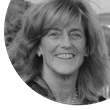

DEPARTMENTS

RISK
MARY O’REILLY, PhD, CIH, CPE, FAIHA, is an adjunct assistant professor at the University of Albany School of Public Health, current president of Workplace Health Without Borders, and a past chair of the AIHA Risk Committee.
Risk Discourse is a recurring column in The Synergist that has been reviewed
by a subcommittee of the AIHA Risk Committee.
Send feedback to The Synergist.
Risk Discourse: Framing the Problem
BY MARY O’REILLY
Once upon a time there was a woman who needed to cross a stream to gather food. Several experts offered advice. A hydrologist assured her that the stream was stable with a manageable flow rate and not too deep, a physiologist assured her that the stream was not too cold to disturb the equilibrium of her body temperature, and a meteorologist assured her that no rain or storms were in the forecast, yet she refused to cross. In exasperation, the experts asked her why. She answered that there was a footbridge a few kilometers upstream.
As risk experts, occupational and environmental health and safety professionals view ourselves as problem solvers, which we often are. But one of the most crucial steps in solving a problem is framing the problem. The experts in the story frame the problem in terms of their own specialty, while the woman uses her own mental models to assess the world and make decisions on what is acceptable or unacceptable (that is, too risky). In this context, judging risk is personal and not absolute. It depends on both the situation—including cultural and societal norms—and the individual assessing the risk.
AN ESSENTIAL TOOL
Health professionals focus on the prevention of adverse outcomes. Each environmental and occupational risk can be thought of as an interaction of two similar primary variables. In public health, the primary variables defining risk are the severity of an outcome and the likelihood or probability that the outcome will occur. In occupational hygiene, the primary variables are hazard and exposure. Defining risk as a function of hazard and exposure clearly makes exposure assessment one of the prerequisites to determining occupational risk. Focusing on exposure assessment to reduce risk worked reasonably well during the 20th century to improve worker health. Exposure assessment will continue to be an essential tool, both for characterizing initial risk and evaluating the effectiveness of interventions.
Judging risk is personal and not absolute. It depends on both the situation—including cultural and societal norms—and the individual assessing the risk.
But several issues have emerged over the last few decades that undermine the effectiveness of using single exposure assessments to evaluate risk without including other variables such as simultaneous exposures to multiple chemicals, the effects of mental health, and the physiological consequences of stress from all causes. Simultaneous exposures—for example, to noise and chemicals, or to heat and pesticides—introduce variables that can’t be addressed through exposure assessment of just one stressor. Mental health has increasingly been a topic of focus in the occupational arena; for example, the NIOSH Total Worker Health program has emphasized the idea that workers bring the effects of workplace exposures and stress to their homes and communities, and, conversely, bring the effects of home and community exposures and stress to work. Being on call 24/7, working multiple jobs to make ends meet, low pay, and a lack of health insurance and sick leave are being recognized as detrimental to worker health. In addition, work has some effects on individual and collective mental health that are associated with adverse outcomes such as workplace violence and suicides. We will miss these connections if our framing of the problem focuses only on the workplace.
MENTAL MODELS
Now, the rest of the story: when she crossed the stream, the woman nearly fell off the footbridge because the planks were rotting and the handrail wasn’t secured. Would it have been less risky if she had listened to the recommendations of experts? All four individuals in the story had their own mental models of the stream and what was important to consider when crossing. None were wrong, although the upstream bridge might have benefited from an expert evaluation.
Mental models, by themselves, are neither right nor wrong. Their usefulness, however, often changes with the context and depends on how well they are integrated into a comprehensive framing of the problem. Understanding each participant’s perspective is as important as a reliable, reproducible, and relevant exposure assessment for analyzing and communicating risk.